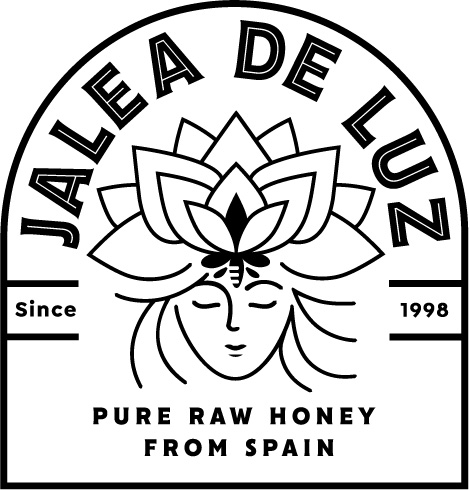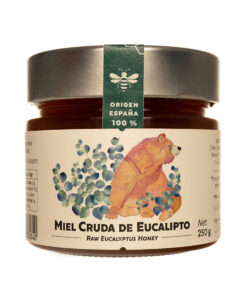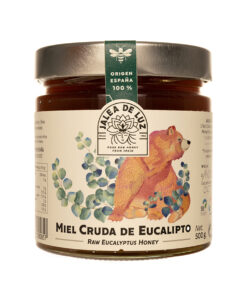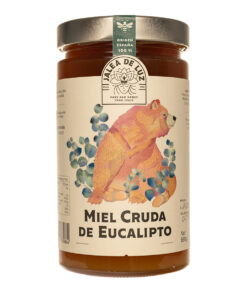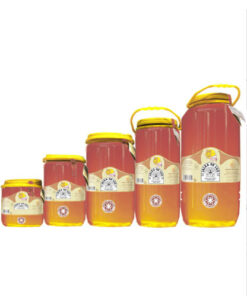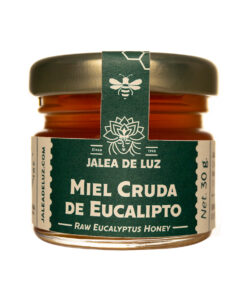Eucalyptus Honey
Origin : Spain and other areas of the Iberian Peninsula.Representative species: eucalyptus ( Eucalyptus sp.).
Main floral composition : eucalyptus ( Eucalyptus sp.), Chestnut (Castanea sativa) and native Cantabrian wild flora.
Production period : early spring.
Color : Amber to dark ochre.
Flavor : woody, intense, aromatic, durable.
Peculiarities: raw honey, pure, not homogenized, not filtered, without added sugars.
Conservation : keep dry, semi-dark and cool.
** In its natural process, honey crystallizes and hardens according to various parameters (temperature, floral origin, etc..).
Characteristics of Eucalyptus Honey
Of captivating and ancestral woody flavor with light acidic notes and fragrant aroma extremely durable, shows us vivid colors ranging from amber tones to dark ochres. It highlights the tendency to medium crystallization in fine and delicate crystals.Mysterious forests sheltered by the imposing Sierra asturiana, gather a wide bed of eucalyptus altivos (ocalitos) that unfold their flowers at the icy dawn, to supply the tireless bees, pollen and nectar essential in the production of this curious honey filled with pride as Mother Earth, protecting in its bosom the eternal and tireless worker bee that pecorises in delicate and melodious dance during the warm hours of the day.
Eucalyptus Honey Excellencies
Like all our excellent range of melliferous products (propolis, royal jelly, pollen,..), the natural honey of eucalyptus harvested in natural places by our bees, strictly meets all the requirements of any pure natural product:• Pure: through the libation of pollen and nectar of flowers, and secretions of plants and sucking insects of native species, our bees proceed to its transformation and storage in the honeycombs of the hive obtaining a 100% pure product, not altering this process any factor alien to those that nature itself provides.
• Non-homogenized: we never mix natural honeydew from different geographical or floral sources, handling and packing them in individual batches, in order to maintain all its essence and purity.
• Unfiltered: we never filter it, because in this way we preserve all the natural properties of origin, thus achieving an excellent natural product without parangon.
• No added sugars: our honey has countless advantages, it is pure essence free of additives, being preserved just as the bee produces it in the hive, possessing only natural sugars typical of unadulterated natural honey.
• Raw: it is not subjected to either processes or pasteurization, or overheating (more than 40 º), thus preserving all the vitamins, nutrients and enzymes, as well as their taste and olfactory qualities that already had in the hive •
Usage tips
The natural honeys of eucalyptus flowers collected by our bees have unique characteristics, so if we want to take advantage of them, it is advisable to take them directly, savoring them inside the mouth as long as possible before ingesting them. To make them more manageable in those cases that are preferred diluted, it is recommended at most, warm the "bain-marie" to temperature that never exceeds 40 º to avoid the loss of attributes.Conservation tips
Keep in a dry, semi-dark and cool place to keep intact in a natural way all its qualities.Eucalyptus Honey, where does it come from?
Natural Eucalyptus Honey is produced as a result of libation to extract pollen and nectar from bees, in the flowers of eucalyptus (Eucalyptus sp.), Chestnut (Castanea sativa) and native Cantabrian wild flora, adding to this sweet floral composition resinous substances several shrubby or arboreal species that are collected by pecoreadoras.Eucalyptus trees are very rustic perennial trees with unique characteristics and great invasive power. Upright and high in height, they have trunk of whitish silvery bark, oval leaves of grayish color (which in later ages increase its length and turn the color to bluish green, possessing also an essential oil of intense aroma and powerful balsamic effect), and solitary flowers or umbelliferous white especially attractive for bees, which give rise to fruits in the form of Woody capsule.
Eucalyptus Honey, etymology and History
It comes from the Greek "eu" (“good”, "pretty",..) and kaliptos ("escondido"). It is a native tree of Australia, Tasmania and nearby areas, which was introduced in Europe in the late nineteenth century, used in principle for its ornamental value, then grown in large plantations because of its rapid growth, used as raw material for the wood industry, paper and others.As a result of this first European incursion, I end up spreading throughout the world, mainly in Brazil, Spain and India, as it generated great benefits for these flourishing economies.
Some legends narrate that in prehistoric times, a group of aborigines gathered various types of wood to try to make fire, when suddenly they heard a sound for them terrifying, leading them to believe at the beginning that they were evil spirits, until I finally noticed that the sound was very nice and came from the effect of the wind to pass through the trunk of a tree hollowed out by termites; this led to the "didqeridoo" (a wind instrument used in ancient rites to connect with the spirits of ancestors).
Throughout history it has been a very appreciated element, frequently used eucalyptus leaves in various applications.
Recipes with Eucalyptus Honey
honey cakePut in preheated oven at 170º C. a tray mold to use. Manually mix whole grain spelt flour, Ceylon cinnamon, baking powder and a little sea salt. Drill the core by adding brown sugar, birdseed milk and natural honey from eucalyptus flowers, evenly blending the mixture. Apply the whole set to the mold tray giving a natural, smooth and continuous shape. Heat in the oven until it acquires golden tones; at that time let cool and we already have an ideal dessert and very natural.
